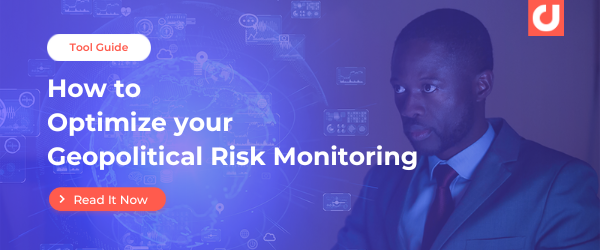How to Effectively Manage Reputational Risk Challenges?
Why is reputation risk a "different" risk?
Unlike market and credit risks, whose impact can be contained, reputational risks often arise from the amplification of another problem that can occur anywhere. In fact, business risks have the potential to spread into secondary "aftershocks" of reputational risks.
In contrast to standard risks, reputation management may not have all the information about causes, issues, and affected parties.
A real threat
Reputation risk is not something new. In 2010, executives who participated in a survey by the Economist Intelligence Unit ranked the threat from Reputation Risk as a top concern. With a score of 52, Reputation Risk was already perceived as much more important than Regulatory Risk and Human Capital Risk, which both scored 41.
Let’s look at the specifics of reputation risk, types of risk, impacts on the organization, the people in charge, and the tools deemed helpful in monitoring, measuring, and managing reputation.
I. Reputational risks: a risk in itself or a consequence of other risks?
Some executives in charge of this type of risk believe that reputation risk is the starting point. If you don't have a reputation, you don't 'do' business. This is the belief of Dr Guruswami Raghavan, Professor of Finance at the SDM Institute for Management Development in Mysore.
And then there is the view of a former risk manager of Hilton Hotels who saw Reputation risk more as a 'fixer-upper', rather than a subject and risk in itself.
If we stick to digital reputation risks only (e-reputation, digital reputation), we can imagine this typology of risks incurred and impacts.
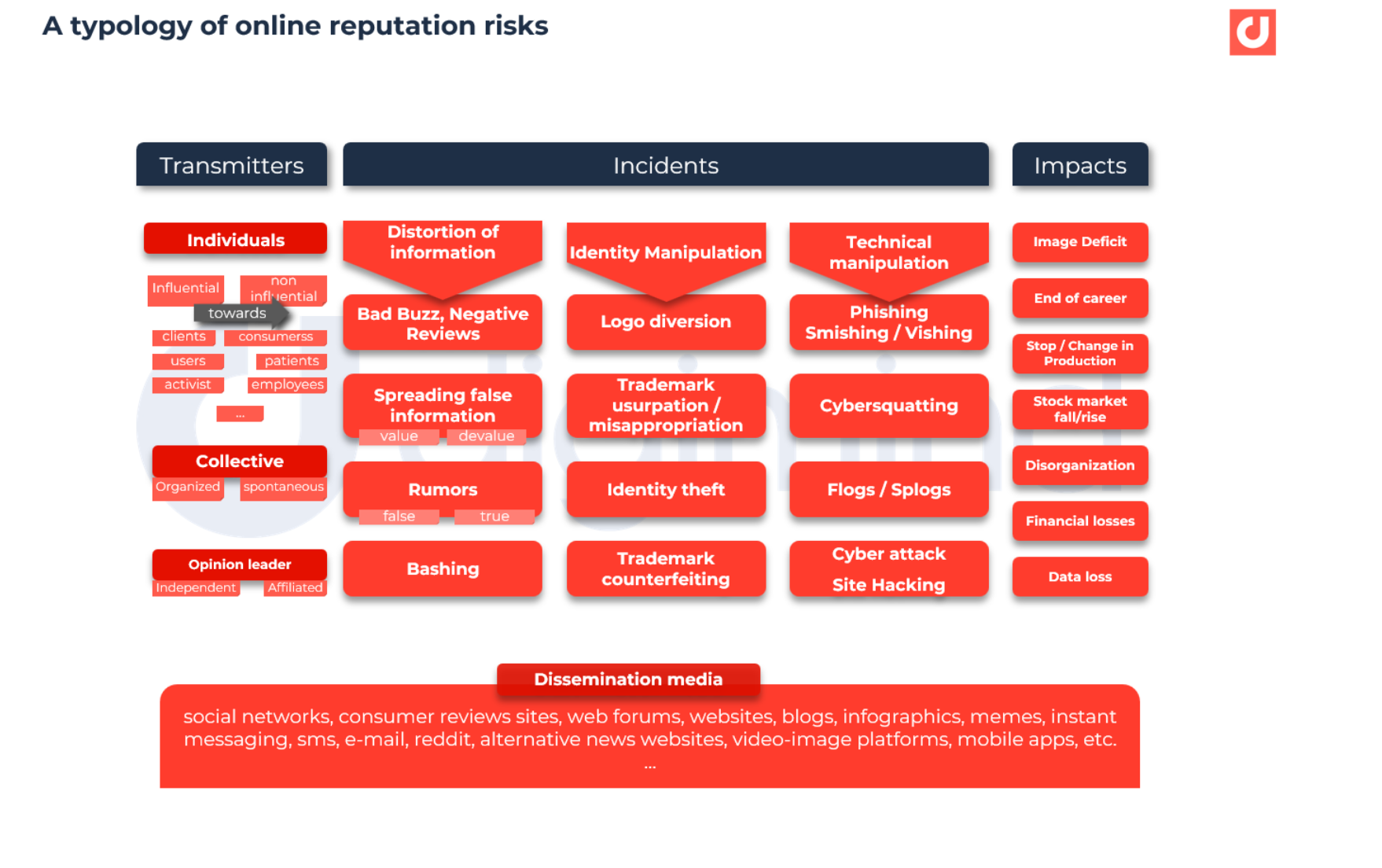 online reputation risks
online reputation risks
In many cases, the reputational crisis is global and the digital component is only one facet: reputational risk is a consequence of other types of risk- since each type of initial risk has the potential to cause some kind of secondary wave of reputational damage.
For food brands, for example, a food crisis and product recall could result in health, production, standards and safety risks that could negatively impact the brand's reputation and potentially last for years. This duration depends on various factors: the management of the crisis by the company (reactivity, type of response), the media treatment, the brand's reputation, post-crisis communication and....the consumer's capacity to forget.
The impact of reputational damage can then be felt throughout an organization. This is what emerges from the WTW Global Reputational Risk Management study (1) . 200 professionals took part in the survey (risk managers, reputation managers, corporate communication, marketing, executives, etc.) on 4 continents.
 Major risks map
Major risks map
Most risk managers surveyed in the WTW study believe that their companies can suffer significant losses due to reputational damage. Loss of revenue and loss of customers are seen as the main problems that companies face as a result of reputational damage.
Reputation damage, however, can have a profound impact across a business, and it can lead to recruitment and retention issues, a less attractive employer brand, the loss of licenses to operate, or a need for increased regulations in the sector, to name just a few.
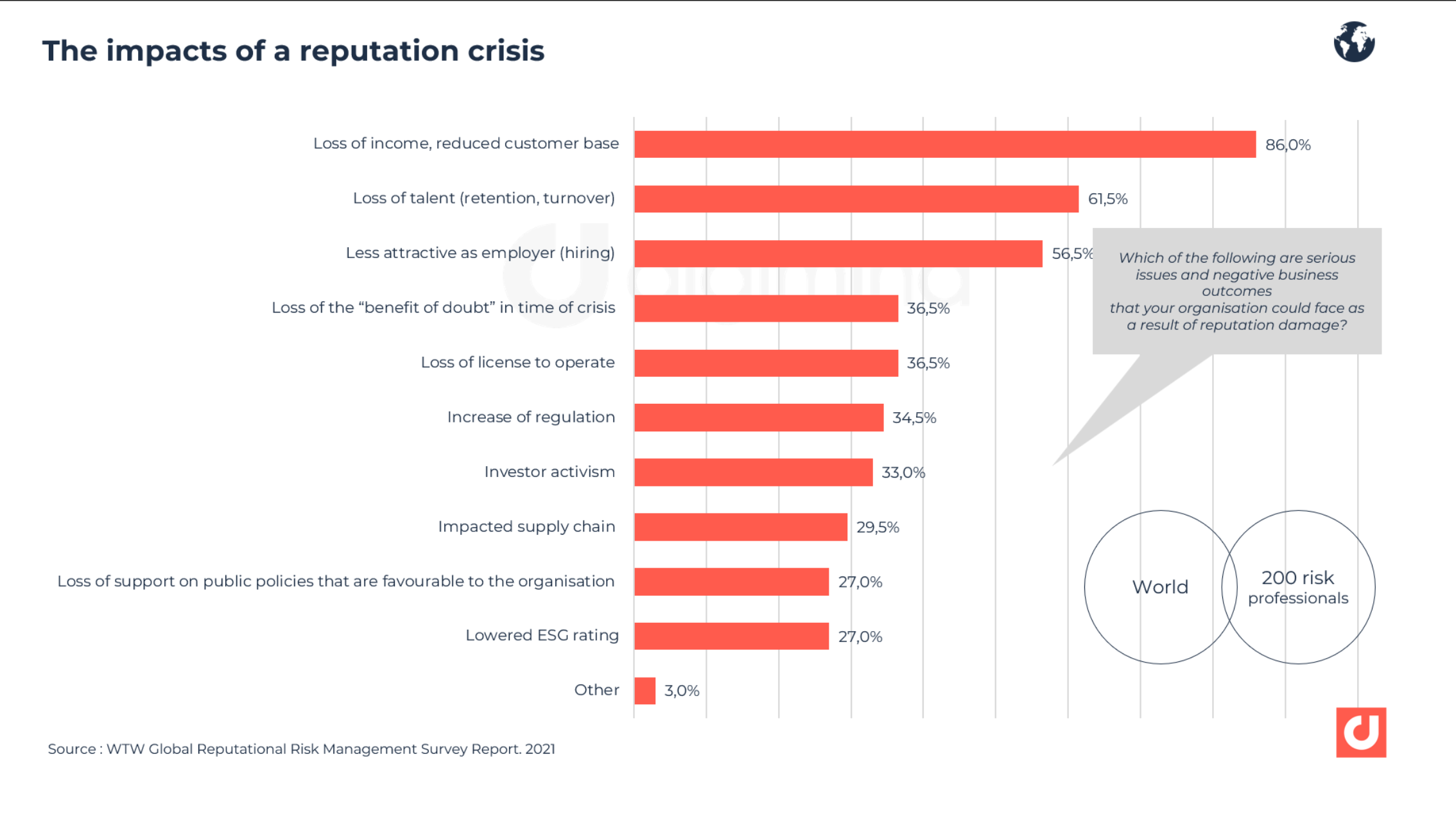 The impacts of a reputation crisis
The impacts of a reputation crisis
The key point is that, in the classic Risk Management process, risks have a very well defined impact and causes, and are attached to a well identified department or process in the organization. For example, a customer who defaults on payment is attached to the Sales Department, and the impact will be limited to managing the financial impact. Deciding who is in charge of the risks and what needs to be done to reduce the risk (e.g. requesting a guarantee) is relatively easy. Similarly, in traditional Risk Management, the departure of a key engineer is seen as a Human Resources risk with known and well-documented impacts and relatively easy implementation of risk reduction techniques.
But reputational problems can systematically arise in terms of secondary damage to almost everything the company does. If we take the 2 previous examples:
- Poor control of credit risk (related to default) will initially result in financial cost and capital depletion. However, the perception that a company is unable to manage these risks can create doubt in the minds of its partners, customers and suppliers.
- Similarly, the departure of the key engineer, beyond the immediate human resource risks, could subsequently lead to delays or quality problems that will be noticed and not welcomed by customers.
Thus, different types of risk may hit certain departments or services, but each has the potential to cause the secondary wave of reputational damage. Amplified and sometimes distorted by the (social and mainstream) media, it can easily prove even more damaging to the company's bottom line and shareholder value in the long term than the original risks.
In short, generally, business risks can be considered and managed independently for their effects on the organization, but they all have the potential to propagate into secondary 'aftershocks' of reputational risks.
II.Who is in charge of risk and reputation management in the organization?
Brand value is usually the domain of the Marketing Director or the Communications Director. But, the WTW study shows that in terms of risks, responsibilities are more spread out and therefore potentially diluted. Additionally, they are not only the responsibility of risk managers as for other so-called "classic" risks.
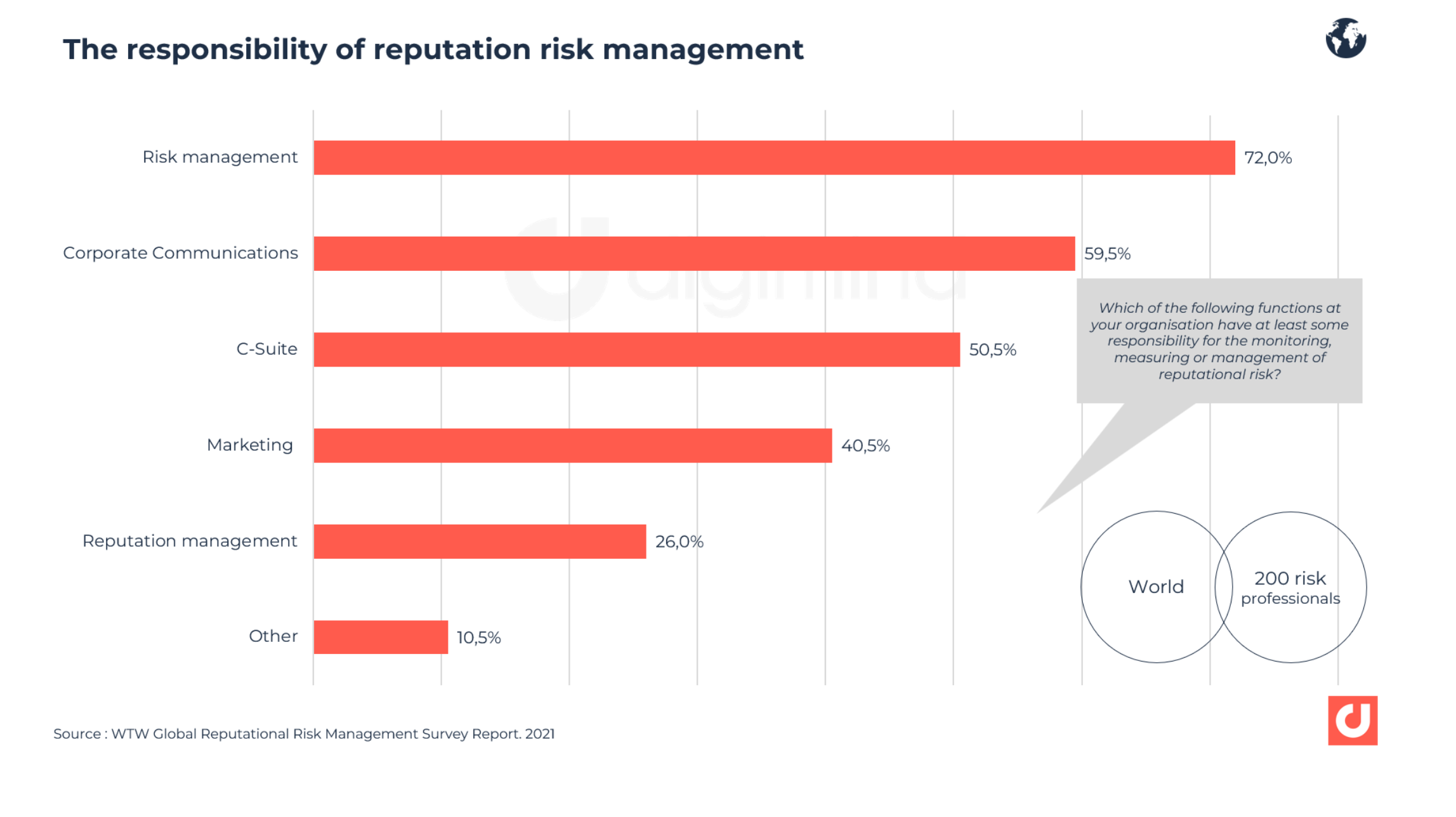 The responsibility of reputation risk management
The responsibility of reputation risk management
Instead of being treated as merely another business risk, reputational risk is managed by a range of departments, such as marketing, communications, and public relations.
But reputation risk is not like other risks. It is a risk that must be treated as a strategic issue at the company level. Although risk management is the most cited function, many other functions not specialized in risk management are involved in reputation management.
III. Reputation risk management tools
Risk managers feel that they do not have the tools and support they need to manage reputation risk effectively.
There is a dissonance between data-driven management of other business risks and reputation marketing, communication and HR teams that often have to manage reputation risks without the necessary tools or skills, the WTW study reveals. It shows that the lack of reliable data and lack of clear methodologies are the most common challenges in monitoring, measuring, and managing reputation risk.
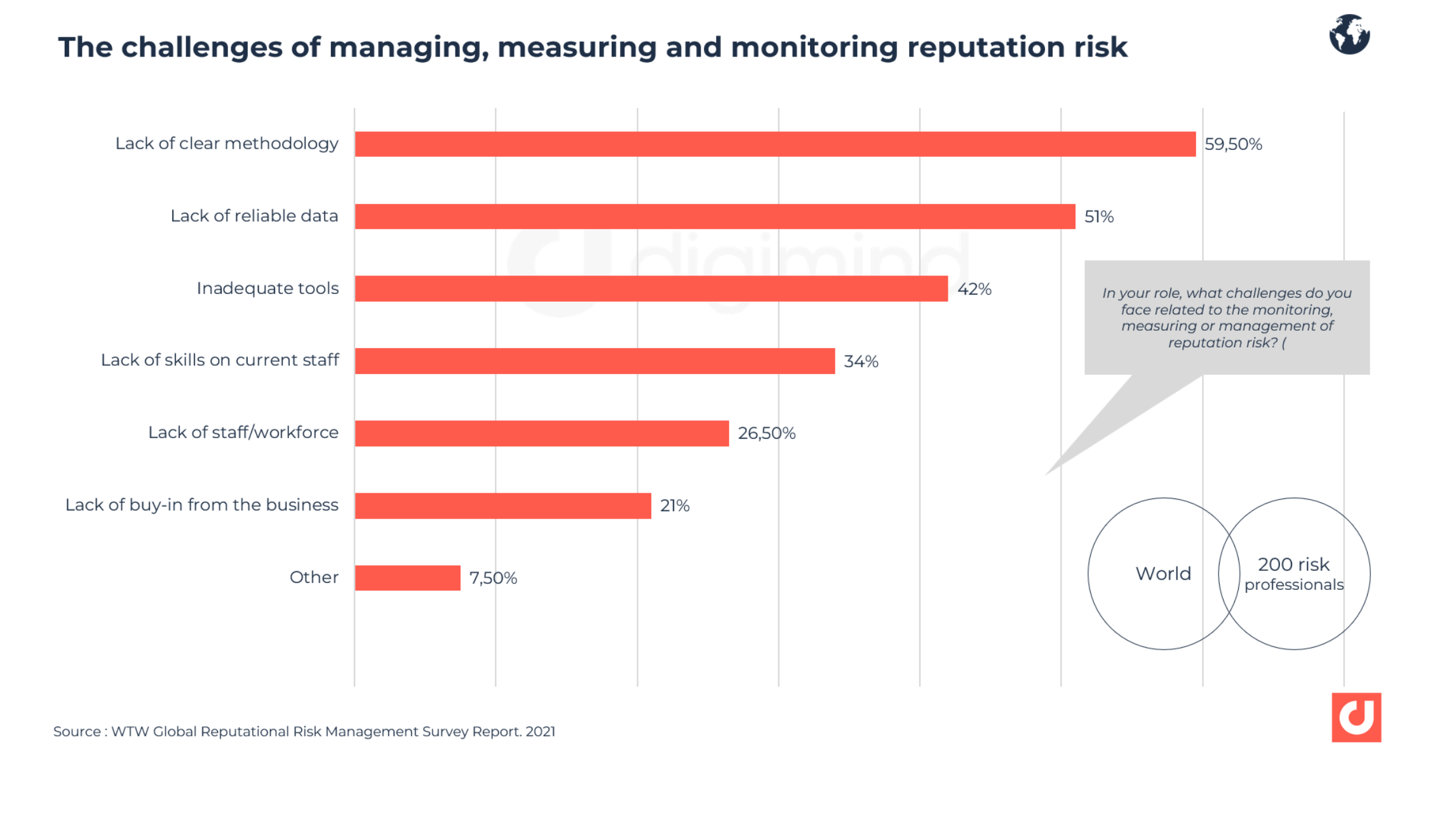 The challenges of managing, measuring and monitoring reputation risk
The challenges of managing, measuring and monitoring reputation risk
a. What reputation management and monitoring tools are available in organizations?
- 44% of survey participants say that there are none, or that they were not aware of their existence
- 20% report relying on manual processes, word of mouth and social networks
- and only 35.5% stated that they either had a tool in place or benefited from sectoral reports
b. Two reputation management tools considered useful
Equally, the majority of respondents consider two types of tools to be somewhat or very useful:
- A real-time reputation management dashboard with a comprehensive index problems, including insured risks, affecting the organization
- A reputation impact indicator that summarizes with a calibrated score the importance of the organization's visibility and its role in the online public discourse
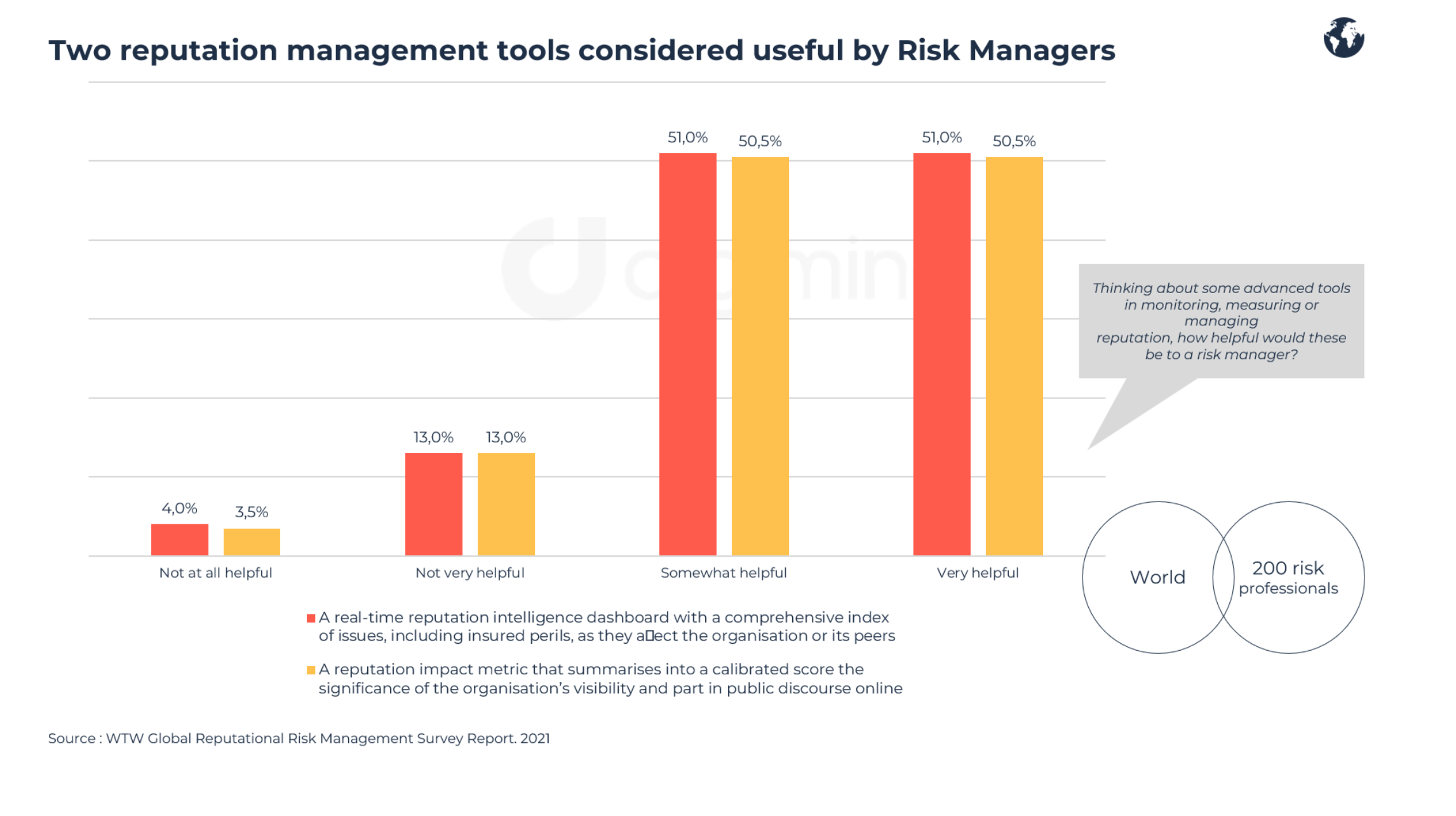 Two reputation management tools considered useful by Risk Managers
Two reputation management tools considered useful by Risk Managers
c. Methods and tools considered most useful for reputation management

The methods and tools considered most useful for reputation management
Along with benchmarking, media monitoring, stakeholder surveys and big data tools are considered the most useful methods and tools for managing reputation risk.
As you can see, a social media listening tool is ideal for monitoring, managing and measuring reputation.
- It allows the monitoring of various risks that can affect the reputation of an organization and its stakeholders through the monitoring of millions of sources on the web and social media
- It allows for the measurement of reputation and risk through a number of relevant indicators and KPIs: share of voice, reach, spread, engagement, people talking about it, evolution of sentiment, net sentiment etc.
- Finally, it allows for the management of reputation by sharing the right information, insights, and indicators with the right people in the organization via different types of deliverables, depending on the recipient and their function: real-time dashboard, email, reports, alerts, etc.

